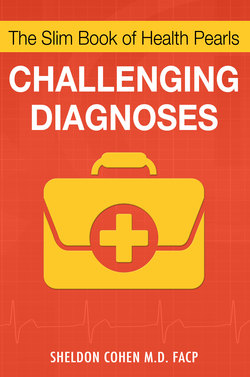Читать книгу The Slim Book of Health Pearls: Challenging Diagnoses - Sheldon Cohen - Страница 6
На сайте Литреса книга снята с продажи.
ОглавлениеOTHER LYMPHOID TISSUE
These are secondary lymphatic organs: lymph nodes and spleen:
LYMPH NODES
Lymph vessels, lying in body tissues, course back toward the heart carrying body fluids known as lymph, a clear yellowish watery substance derived from body tissues that pass through lymph channels and oval structures known as lymph nodes. The lymph finally returns to the blood circulation of the body through the largest lymph vessel (thoracic duct) in the upper chest area.
The lymph nodes are from one to twenty-five millimeters in length (0.04 to 1 inch). Lymph nodes are scattered throughout the body, but predominantly concentrate in groups such as the axilla (under the arm), and groin area. The microscopic architecture of a lymph node includes an outer cortex and inner medulla.
The outer cortex contains follicles, the outer rim of which contains densely packed T lymphocytes plus macrophages. The inner region of the follicles, known as germinal centers, contain B lymphocytes. It is here that the B-lymphocytes evolve into plasma cells that make proteins (antibodies) that attack foreign or non-self cells. These plasma cells, along with some T cells, migrate to other parts of the body.
In the inner medulla, there are lymphocytes, macrophages, and plasma cells packed together in strands known as medullary cords.
The purpose of lymph nodes is to filter foreign substances from the lymph as it passes toward the blood stream. Here the macrophages attack (phagocytize) these foreign substances, and the lymphocytes kill by immune response.
SPLEEN
The spleen is an organ, about the size of a fist, located under the rib cage below the left diaphragm. The spleen has two different types of tissue:
•White pulp consisting mostly of B cell lymphocytes
•Red pulp consisting of red blood cells, lymphocytes, macrophages, other white blood cells and plasma cells.
Since no lymph vessels enter the spleen, it does not filter lymph. The spleen receives blood from the splenic artery that branches to it from the aorta. As the blood moves through the spleen the T cells monitor it for any non-self invaders. If they recognize any suspicious non-self or invading cell they will call up the appropriate memory B cell. This memory B cell will divide rapidly and produce antibodies (a protein formed in response to a specific antigen that reacts with or neutralizes that antigen). Then the antibodies will attack the invading antigen.
The macrophages in the spleen will destroy worn out red blood cells (they only live about three months), and destroy worn out platelets (they live a matter of days).
That concludes the discussion of the lymph nodes and the spleen, but there are other areas where lymphocytes congregate. Pressing the tongue against the interior of cheeks or lips will identify (for want of a better description) little round balls. These are lymphatic nodules and they are oval to rounded collections of lymphatic tissue. They are scattered throughout the connective tissue of our mucous membranes lining the gastrointestinal tract, the bronchial tubes, the reproductive tract, and the urinary tract. These nodules differ from lymph nodes: they do not have a capsule (outer cover). These lymphatic collections stand guard against any invaders that may penetrate the mucosal barrier. The name for this lymphoid tissue is mucosa associated lymphoid tissue (MALT). Included in this category of mucosal guards are patches of lymphoid tissue known as Peyer’s patches (located under the mucosa of the small intestine), and the five tonsils that form a ring in the back of our mouths (oropharynx).
